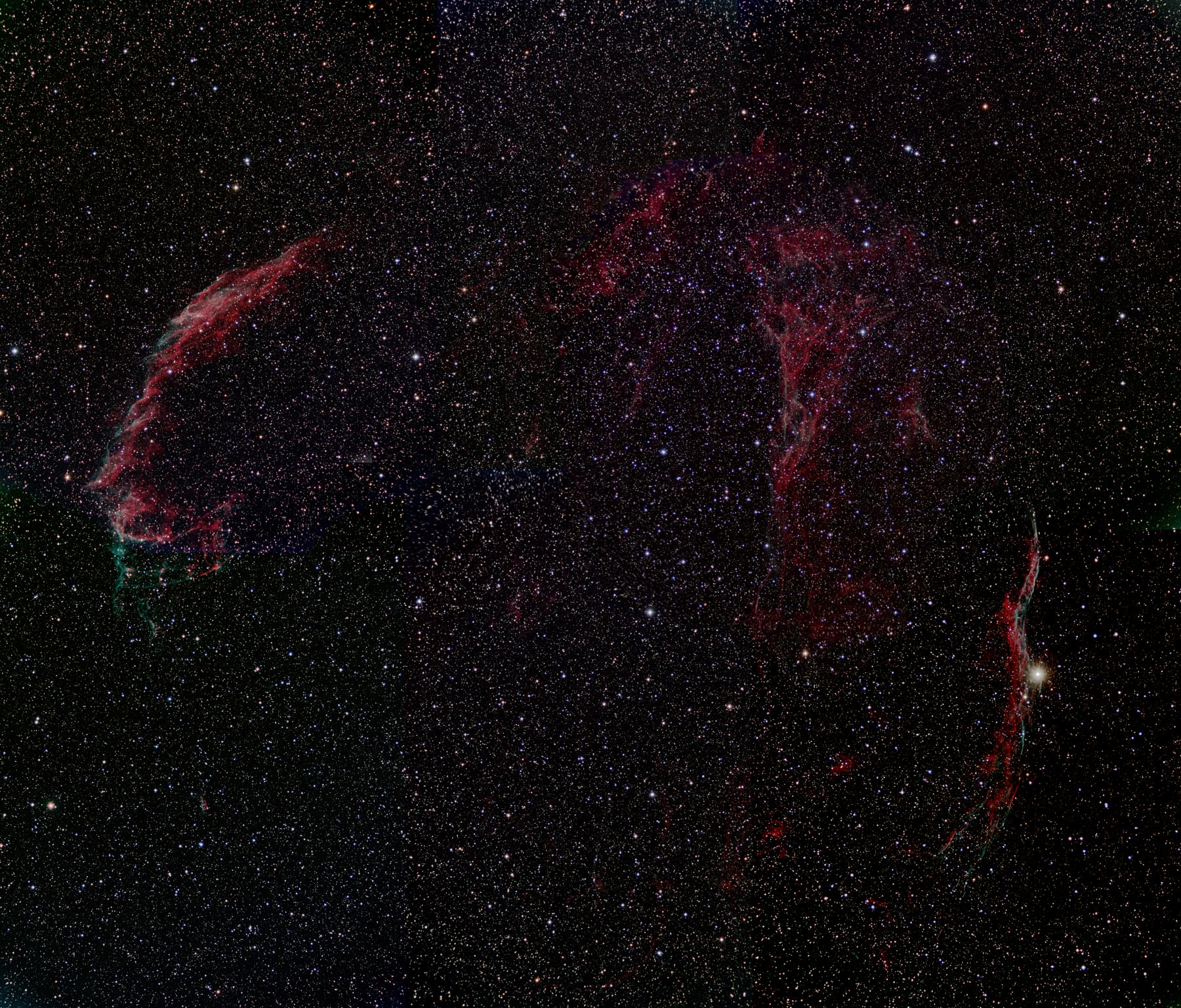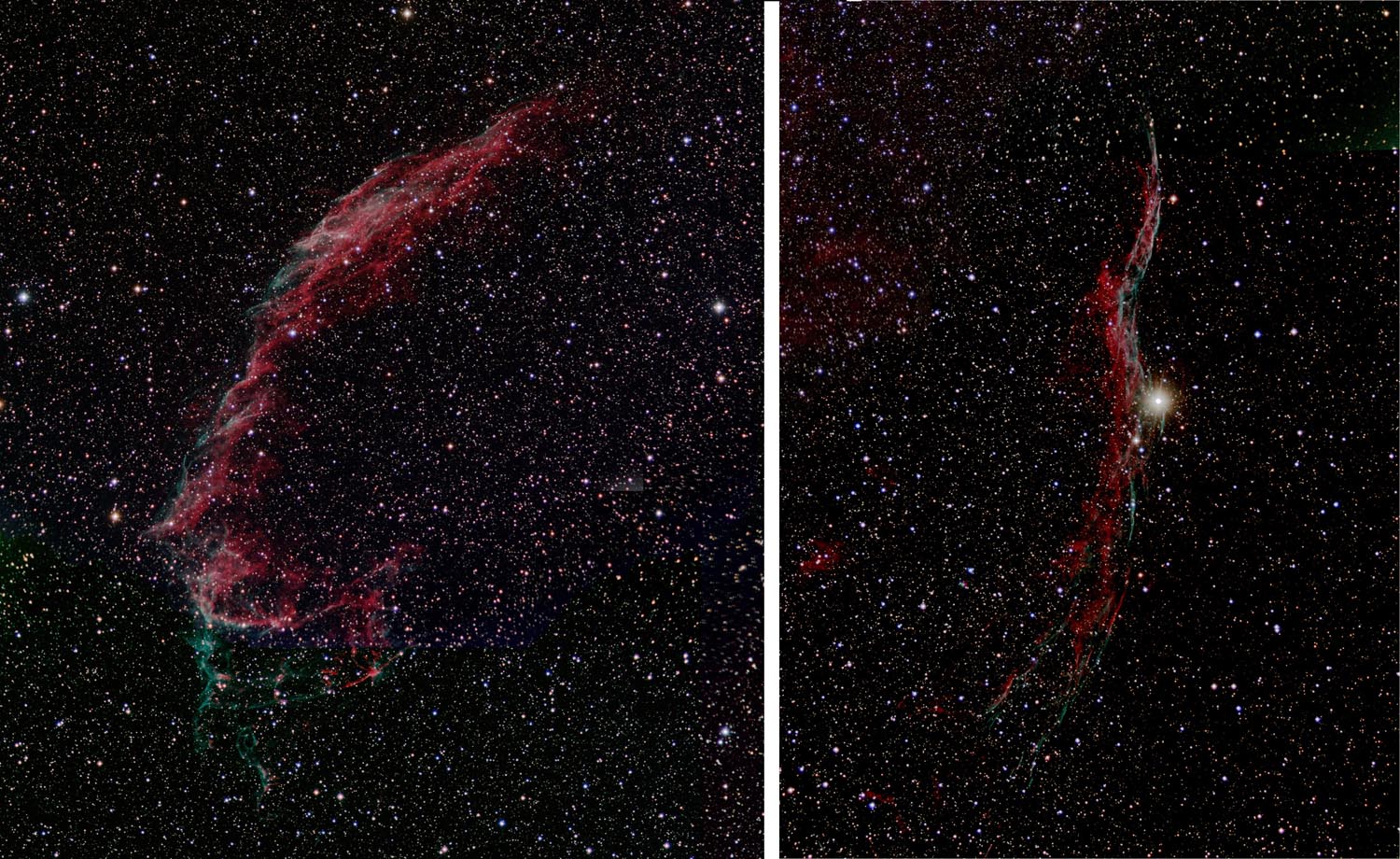
 | SOCO Blog |
04 July 2015
CELESTIAL FIREWORKS— THE VEIL NEBULA
A lot of people look forward to the 4th of July holiday for the fireworks displays. I was watching the annual fireworks display at nearby Buffalo Springs Lake last night, and was impressed by the multi-colored bursts of the pyrotechnic missiles fired high above the ground. Each burst produced an expanding spherical shell of fiery fragments of various colors— reds, blues, greens. As impressive as they were, they are dwarfed by what our galaxy occasionally produces. When supermassive stars get old, they just don't burn out— they end their life in a cataclysmic explosion called a supernova. Most of the star's material is blasted out into space, with only a tiny fragment remaining as a neutron star or black hole. The expanding shell of ejected material collides with gases in the interstellar medium creating a glowing supernova remnant that we can observe long after the star is gone.
Supernovas are rare events— on average only around 3 should occur every 100 years in the Milky Way. The last one that was directly observed in our galaxy was Kepler's Star in 1604. Perhaps the best-known is the supernova of 1054 AD, recorded by Chinese observers and recognized as the creator of the Crab Nebula (the first object appearing in Messier's list). But, around 5,000-10,000 years ago (there is quite a bit of uncertainty about the date), a star in the present-day constellation of Cygnus (the Swan) exploded in a supernova and produced a remnant that delights astronomers today. This is the Veil Nebula, also called the Bridal Veil Nebula, the Cirrus Nebula, the Cygnus Loop, and the Filamentary Nebula. My imagery of it is shown in Figure 1.

Figure 1. NGC 6990, the Veil Nebula in Cygnus.
Like the fiery 4th of July pyrotechnic, what we see in the Veil Nebula is the shell of the explosion. Expanding at a speed of around 600,000 km/hr, the object has a diameter on the order of 100 LY and is thought to be around 1470 LY away. Visually, it spans approximately 3 degrees against the backdrop of the Milky Way (around 6 times the diameter of the full moon). Due to its expansion over the millenia, we don't see a complete shell from the explosion, but rather shards of the shell like pieces of a balloon that has popped. Since its discovery in 1784 by William Herschel, the Veil Nebula has been studied by numerous astronomers. The overall nebula has the designation NGC 6990, but various components have been given individual designations. These are shown in Figure 2. All the named compents shown in Figure 2 can be found in my image. While a number of radio and X-ray sources have been found within the region of the nebula, the remnant of the star at its center that exploded has not been positively identified.

Figure 2. The Veil Nebula and its various components, captured in ultraviolet light
Source: Wikipedia.
The brighest segment of the nebula is the Eastern Veil, composed primarily of NGC 6992. An expanded view of this object is shown in Figure 3. The red filaments shine through ionized hydrogen (Hα) emissions, while the green filaments shine through ionized oxygen (OIII) emissions. This segment of the nebula has a visual magnitude of around 7, but its size makes the overall surface brightness lower. Still, it can be seen through a small telescope under dark sky conditions. The Western Veil (Figure 4) is anchored by the magnitude 4.2 star 52 Cygni. This yellow star is only around 201 LY away, so it is a foreground object and not physically associated with the nebula.

Figure 3. (left) NGC 6992, the Eastern Veil. Figure 4. (right) NGC 6960, the Western Veil.
The image in Figure 1 was created from six separate color images of the nebula mosaiced to contain the whole object. Each of the six images was itself made from six 5-minute exposures in each of the red, green and blue spectral bands. These images were acquired on three nights back in July and August of 2014. At the time, I wasn't satisfied with the results of processing the images to produce color composites. Now that I have my image processing procedures standardized, I re-processed the imagery to produce the results shown in Figure 1. This processing was greatly facilitated by SIAM, which allowed me to do all the image processing in one evening (previously it would have taken me about a week!).
The results of supernovas are interesting to observe, but we should keep in mind that we owe our very existence to them. All the elements heavier than oxygen that make up the earth and the living organisms on it (including you and me) were created by supernova explosions. Thus, the death of supermassive stars literally spreads the potential for life throughout the Universe.
 Return to SOCO Blog Page
Return to SOCO Blog Page
 Return to SOCO Main Page
Return to SOCO Main Page
Questions or comments? Email SOCO@cat-star.org